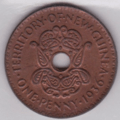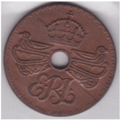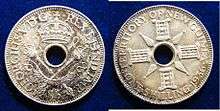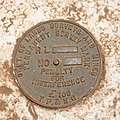New Guinean pound
The New Guinean pound was the currency of the Australian Territory of New Guinea between 1915 and 1966, and replaced the New Guinean mark when Australia occupied the former German colony at the end of World War I. The New Guinean pound was subdivided into 20 shillings, each of 12 pence, and was equal to the Australian pound. The Australian currency circulated alongside coins issued specifically for New Guinea between 1929 and 1945.[1] New Guinea coins ceased to be produced in 1945, and production of Papua New Guinea resumed in the 1970s.
| New Guinean pound | |
|---|---|
| Denominations | |
| Subunit | |
| 1/20 | shilling |
| 1/240 | penny |
| Plural | |
| penny | pence |
| Symbol | £ |
| shilling | s |
| penny | d |
| Coins | 1/2d, 1d, 3d, 6d, 1/- |
| Demographics | |
| User(s) | Territory of New Guinea |
| Valuation | |
| Pegged with | Australian pound, which was in turn pegged with the British pound at par. |
This infobox shows the latest status before this currency was rendered obsolete. | |
Between 1942 and 1945, the Oceania pound circulated, issued by the Japanese occupiers. Australian coins and banknotes resumed circulation after the war and continued until the Papua New Guinean kina, which was introduced on 19 April 1975, replaced the Australian dollar at par. The Australian dollar continued to be legal tender in PNG until 1 January 1976.
Coins
In 1929, nickel halfpennies and pennies, as well as cupro-nickel pennies were introduced. These (as well as all subsequent New Guinean coins) were holed. The inscription on the reverse read: Georgius V. D G Rex et Ind. Imp., which translates from Latin as, "George the Fifth, by the Grace of God King and Emperor of India". The inscription on the obverse reads Territory of New Guinea. These coins were followed in 1935 by threepences, sixpences and shillings. The following year, pennies were minted depicting King Edward VIII. That was relatively rare because Edward abdicated less than eleven months after succeeding to the throne, meaning that most dominions and colonies which featured the British monarch on their currency had not yet redesigned their coins. Coins of varying denominations were minted under the reign of George VI, beginning in 1938. In 1945, production of New Guinea coins ceased until Papua New Guinea started minting its own currency in the 1970s.
Gallery
 1936 penny, obverse
1936 penny, obverse 1936 penny, reverse
1936 penny, reverse 1936 shilling
1936 shilling Survey marker bearing the initials of the Territory of Papua and New Guinea and indicating a fine for interference denominated in New Guinean pounds.
Survey marker bearing the initials of the Territory of Papua and New Guinea and indicating a fine for interference denominated in New Guinean pounds.
References
External links
| Preceded by: German gold mark Ratio: at par |
Currency of New Guinea 1915 – 1942 Concurrent with: Australian pound |
Succeeded by: Oceania pound Reason: Japanese occupation Ratio: par |
| Preceded by: Oceania pound Reason: Liberation from Japanese occupation |
Currency of New Guinea 1945 – 1966 Concurrent with: Australian pound |
Succeeded by: Australian dollar Reason: decimalisation Ratio: 2 dollars = 1 pound |